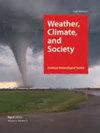美国东南部部分地区与龙卷风和山洪警报重叠相关的气候、脆弱性和公众认知
IF 1.9
4区 地球科学
Q3 ENVIRONMENTAL STUDIES
引用次数: 0
摘要
同时发生和重叠的龙卷风和山洪是一种具有复杂社会影响的气象灾害,因为当龙卷风和山洪警报同时发布时,会提供相互矛盾的公共安全建议。这项工作从跨学科的角度评估了东南部部分地区潜在的龙卷风和山洪(TORFF)事件,重点关注气候、脆弱性和公众对这些灾害的看法。除了相互矛盾的警告建议外,TORFF还对公众构成了挑战,因为它们可能发生在夜间或凉爽的季节,尽管它们在春季最为常见,但这是最不常见的。此外,造成TORFF的风暴往往没有明确的组织,这给预测和通信带来了挑战。在我们的研究区域,响应龙卷风和山洪警报的公众比其他区域的公众更容易受到TORFF的影响,并且可能缺乏车辆和结构来安全应对一种或两种危险威胁。管理调查结果表明,许多人认为他们知道在TORFF中应该采取什么样的保护措施,尽管他们可能不相信自己可能在自己的地区。那些认为自己有可能的人也更有可能做好回应的准备。许多气候和脆弱性特征在NWS县预警区之间以及有时在预警区内各不相同,突出了整个地区不同的沟通和准备需求。该地区大约四分之一的山洪和龙卷风警报重叠,平均持续31分钟。TORFF的频率及其相关的公共安全挑战值得继续调查。本文章由计算机程序翻译,如有差异,请以英文原文为准。
The climatology, vulnerability, and public perceptions associated with overlapping tornado and flash flood warnings in a portion of the Southeast United States
Simultaneous and overlapping tornadoes and flash floods are a meteorological hazard with complex societal implications as, when issued at the same time, tornado and flash flood warnings provide conflicting public safety advice. This work assessed potential tornado and flash flood (TORFF) events in a portion of the Southeast from an interdisciplinary perspective with a focus on the climatology, vulnerability, and public perceptions surrounding these hazards. In addition to the conflicting warning advice, TORFFs present a challenge to the public because they can occur at night or in cool seasons, when they are least expected, though they are most common in spring. Also, the storms causing the TORFFs are often not clearly organized, causing a forecast and communication challenge. The public responding to the tornado and flash flood warnings in our study area is more vulnerable to TORFFs than those in other areas, and may lack vehicles and structures to respond safely to one or both hazard threats. Administered survey results suggest that many believe they know what protective actions to take in a TORFF, though they may not believe they are likely in their area. Those that believe they are likely are also more likely to feel prepared to respond. Many climatology and vulnerability characteristics vary between, and at times within, NWS County Warning Areas, highlighting the different communication and preparation needs across the region. Approximately a quarter of flash flood and tornado warnings overlap in the region, for an average of 31 minutes. The frequency of TORFFs and their associated public safety challenges warrant continued investigation.
求助全文
通过发布文献求助,成功后即可免费获取论文全文。
去求助
来源期刊

Weather Climate and Society
METEOROLOGY & ATMOSPHERIC SCIENCES-
CiteScore
3.40
自引率
13.60%
发文量
95
审稿时长
>12 weeks
期刊介绍:
Weather, Climate, and Society (WCAS) publishes research that encompasses economics, policy analysis, political science, history, and institutional, social, and behavioral scholarship relating to weather and climate, including climate change. Contributions must include original social science research, evidence-based analysis, and relevance to the interactions of weather and climate with society.
 求助内容:
求助内容: 应助结果提醒方式:
应助结果提醒方式:


